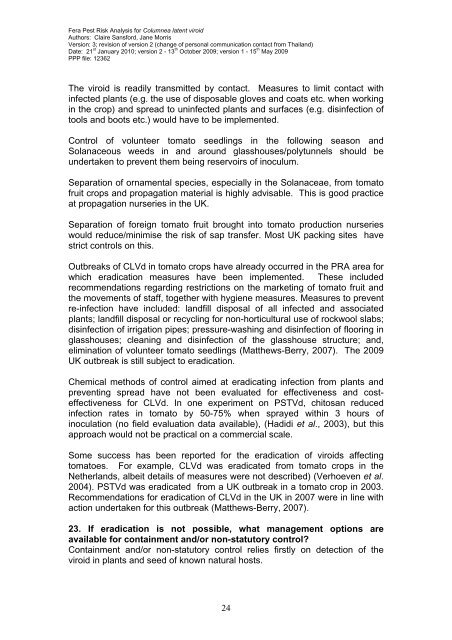Columnea latent viroid - The Food and Environment Research ...
Columnea latent viroid - The Food and Environment Research ...
Columnea latent viroid - The Food and Environment Research ...
You also want an ePaper? Increase the reach of your titles
YUMPU automatically turns print PDFs into web optimized ePapers that Google loves.
Fera Pest Risk Analysis for <strong>Columnea</strong> <strong>latent</strong> <strong>viroid</strong><br />
Authors: Claire Sansford, Jane Morris<br />
Version: 3; revision of version 2 (change of personal communication contact from Thail<strong>and</strong>)<br />
Date: 21 st January 2010; version 2 - 13 th October 2009; version 1 - 15 th May 2009<br />
PPP file: 12362<br />
<strong>The</strong> <strong>viroid</strong> is readily transmitted by contact. Measures to limit contact with<br />
infected plants (e.g. the use of disposable gloves <strong>and</strong> coats etc. when working<br />
in the crop) <strong>and</strong> spread to uninfected plants <strong>and</strong> surfaces (e.g. disinfection of<br />
tools <strong>and</strong> boots etc.) would have to be implemented.<br />
Control of volunteer tomato seedlings in the following season <strong>and</strong><br />
Solanaceous weeds in <strong>and</strong> around glasshouses/polytunnels should be<br />
undertaken to prevent them being reservoirs of inoculum.<br />
Separation of ornamental species, especially in the Solanaceae, from tomato<br />
fruit crops <strong>and</strong> propagation material is highly advisable. This is good practice<br />
at propagation nurseries in the UK.<br />
Separation of foreign tomato fruit brought into tomato production nurseries<br />
would reduce/minimise the risk of sap transfer. Most UK packing sites have<br />
strict controls on this.<br />
Outbreaks of CLVd in tomato crops have already occurred in the PRA area for<br />
which eradication measures have been implemented. <strong>The</strong>se included<br />
recommendations regarding restrictions on the marketing of tomato fruit <strong>and</strong><br />
the movements of staff, together with hygiene measures. Measures to prevent<br />
re-infection have included: l<strong>and</strong>fill disposal of all infected <strong>and</strong> associated<br />
plants; l<strong>and</strong>fill disposal or recycling for non-horticultural use of rockwool slabs;<br />
disinfection of irrigation pipes; pressure-washing <strong>and</strong> disinfection of flooring in<br />
glasshouses; cleaning <strong>and</strong> disinfection of the glasshouse structure; <strong>and</strong>,<br />
elimination of volunteer tomato seedlings (Matthews-Berry, 2007). <strong>The</strong> 2009<br />
UK outbreak is still subject to eradication.<br />
Chemical methods of control aimed at eradicating infection from plants <strong>and</strong><br />
preventing spread have not been evaluated for effectiveness <strong>and</strong> costeffectiveness<br />
for CLVd. In one experiment on PSTVd, chitosan reduced<br />
infection rates in tomato by 50-75% when sprayed within 3 hours of<br />
inoculation (no field evaluation data available), (Hadidi et al., 2003), but this<br />
approach would not be practical on a commercial scale.<br />
Some success has been reported for the eradication of <strong>viroid</strong>s affecting<br />
tomatoes. For example, CLVd was eradicated from tomato crops in the<br />
Netherl<strong>and</strong>s, albeit details of measures were not described) (Verhoeven et al.<br />
2004). PSTVd was eradicated from a UK outbreak in a tomato crop in 2003.<br />
Recommendations for eradication of CLVd in the UK in 2007 were in line with<br />
action undertaken for this outbreak (Matthews-Berry, 2007).<br />
23. If eradication is not possible, what management options are<br />
available for containment <strong>and</strong>/or non-statutory control?<br />
Containment <strong>and</strong>/or non-statutory control relies firstly on detection of the<br />
<strong>viroid</strong> in plants <strong>and</strong> seed of known natural hosts.<br />
24
















